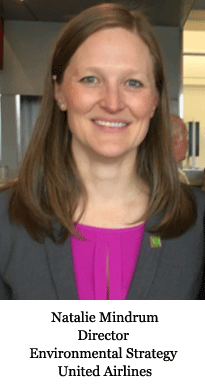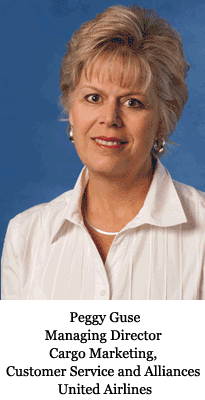
This
Friday, April 22, 2016, is Earth Day.
We are now entering the 46th year
of an environmental movement that continues to inspire
thought, challenge ideas, ignite passion, and motivate
people to action.
“It’s Not Easy Bein’
Green” is a popular song written by Joe Raposo,
originally performed by Jim Henson as Kermit the Frog
on Sesame Street, the long-running children’s
show on the Public Broadcasting System in America.
It’s funny how music can key
thoughts and memories.
Decades ago, our four children would
watch that show and Kermit would sing his somewhat plaintive
song, which was not connected to Earth Day at all.
But recently when somebody wondered
about the status of “Green Cargo,” we thought:
“We’ve heard that song
before”!
Many people across the United States
have certainly seen United Airlines’ B737-900ER
“Eco-Skies” logo jet, part of the carrier’s
Eco-Skies CarbonChoice program.
Here we speak to Peggy Guse, Managing
Director, Cargo Marketing, Customer Service and Alliances
at UA Cargo and Natalie Mindrum, Director – Environmental
Strategy and Sustainability of the UA Environmental
Team, about United Cargo’s commitment to the environment
moving forward.
“United Airlines is committed
to operating an environmentally sustainable and responsible
airline,” assures Peggy.
“This commitment means that
we continuously work to minimize the environmental impact
associated with our operations, and also that we are
always seeking ways to reduce our footprint in the air,
on the ground and at our facilities. The Cargo Division
demonstrates this same commitment in the way we operate
our facilities and how we transport our customers’
shipments.”
“Air cargo’s impact on
the environment is more and more an area of concern
for cargo’s customers, the broader public, and
government regulators worldwide,” Natalie continued.
“United believes that the industry
must collaborate on this subject to avoid a patchwork
of conflicting and difficult-to-manage programs, laws,
and requirements across the globe. That’s why
we continue to be deeply involved in the industry associations
and special working groups that are addressing these
challenges.”
Peggy outlined “two ongoing
environmental initiatives” of which United Cargo
is “particularly proud.”
“In late 2014, United Cargo
began replacing our fleet of LD3 containers with new
Herculight S containers designed by Zodiac Aerospace,”
she said.
“While the Herculight S is
designed to be one of the lightest containers available,
it has proven its durability and strength in our operations.
Based on the number of LD3 movements on United, we expect
to reduce our fuel consumption by two million gallons
and our CO2 emissions by more than 19,400 metric tons
per year when the transition to the lighter containers
is complete. We also work with local vendors to recycle
the approximately 200 pounds of recyclable material
in each retired LD3.
“In 2015, United expanded our
Eco-Skies CarbonChoice program to include cargo customers,
enabling our business partners to easily track and offset
the Scope 3 carbon emissions associated with all their
shipments on United Cargo. CarbonChoice works with Sustainable
Travel International to identify high-quality carbon
offset partners around the globe to enable our customers
to ship carbon-neutral,” Peggy said.
“In March 2016, United became
the first U.S. airline to begin using commercial-scale
volumes of aviation biofuel for regularly scheduled
flights,” said Natalie.
“We’re using the biofuel
in daily operations at our LAX hub, storing and delivering
it in the same way as traditional fuel. Our partnership
with California-based AltAir Fuels is the first of its
kind in the United States; and our equity partnership
with Fulcrum Bioenergy will increase our supply and
commitment to sustainable biofuels.
“United has improved our aircraft
fleet fuel efficiency by 34 percent since 1994. We’re
committed to the common set of goals established by
the aviation sector for taking climate action, including
an average fuel efficiency increase of 1.5 percent per
year until 2020, followed by stabilizing net CO2 emissions
from aviation from 2020 forward, and cutting net CO2
emissions by 2050 to half of what they were in 2005,”
said Natalie.
United Cargo remains committed to
enhancing their present facilities to make them greener
and lessen their environmental impact.
“The most recently built facility
in United’s Cargo’s system—at Chicago
O’Hare—is our model for all future construction
and current operations. It was built to exceed LEED
(Leadership in Energy and Environmental Design) principles,
and the vegetative living roof measures 109,000 square
feet: one of the largest “green” roofs in
North America,” Peggy proudly stated.
“Other leading-edge green features
at ORD include water-saving fixtures; high efficiency
lighting,  heating,
and cooling; and the use of electric and alternative
fuel belt-loaders, cargo towing tractors, and forklifts.
A permeable paver parking lot reduces storm water runoff,
and even this storm water is conserved and reused. Features
of this design, along with ORD’s comprehensive
recycling program, have been incorporated at warehouses
throughout our system,” said Peggy. heating,
and cooling; and the use of electric and alternative
fuel belt-loaders, cargo towing tractors, and forklifts.
A permeable paver parking lot reduces storm water runoff,
and even this storm water is conserved and reused. Features
of this design, along with ORD’s comprehensive
recycling program, have been incorporated at warehouses
throughout our system,” said Peggy.
“From the airline perspective,
United is proud to be one of the global leaders in environmental
responsibility, but we recognize there is much more
to do,” Natalie continued.
“We’re investing in sustainable
biofuels and integrating these into our operation not
only to increase the environmental sustainability of
our enterprise, but to jump-start the aviation biofuel
industry for the benefit of all airlines.
“The steps an organization
involved in air cargo can take to improve their green
footprint are similar to any company (or any individual):
produce fewer emissions, consume less energy, and recycle
and reuse to generate less waste. It’s important
to assess your operation and identify which changes
will make the maximum impact—and then to measure
your success as your program continues. At United, our
largest carbon footprint is associated with fuel use,
so we focus the majority of our efforts on reducing
our fuel use and thus reducing our impact on the environment.”
“Of course,” Peggy added,
“we believe there’s a perfect way for air
cargo forwarders and shippers to be greener: they can
use airlines like United that are working to reduce
the carbon impact of air freight by making significant
fuel efficiency improvements and increasing their use
of biofuels.
“United Cargo customers can
also purchase carbon offsets for their shipping through
our Eco-Skies CarbonChoice program. Beyond that, all
cargo companies can employ lighter-weight containers
and advanced route planning to increase fuel efficiency.
Finally, everyone should use, and then reuse, recyclable
materials throughout their operations,” Peggy
said.
“United maintains a number
of partnerships with environmental institutions and
leaders including Conservation International, Smithsonian
Conservation Biology Institute, and Clean Energy Trust,”
Natalie said.
“These organizations keep us
informed about and updated on environmental best practices
around the world.”
Geoffrey |





